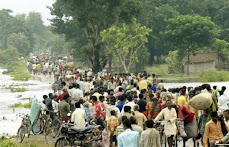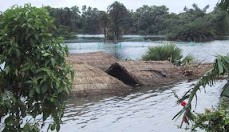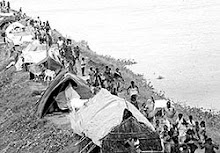Drainage Crisis of North Bihar & Nepal Remains Unattended
New Delhi/17/09/2008: All talk about seeking review of Kosi agreement that created the rationale for embankments and dams on the Kosi river seems like empty rhetoric. The Nepalese prime minister who has reportedly said that he favoured the idea of setting up a high dam on the river Kosi (though it doesn't appear on the Joint Press Statement), at a meeting with Bihar chief minister at meeting hosted by President of JD (U) in Delhi on September 16, 2008. Leaders from Nepal and India have agreed to set up a new mechanism headed by the water resources secretaries of both countries to discuss issues related to flood control, strengthening the embankments and water management.
This is a welcome step provided it is credible, open and independent review of the experience of the past treaty over the last five decades. It is only through such a review in a participatory, democratic way that contours of future steps emerge. Any talk of big dams in absence of this seems like vested interests pushing a high cost project for reasons other than merits of the project, which is the situation today.
The Kosi agreement that was signed in 1954 was amended in 1966 to address Nepal's concerns. According to the treaty, the repair and maintenance of the embankment was India's responsibility. "It is clear that the embankment breached on Aug 18, due to the criminal neglect of those who were responsible at Govt of India and Bihar for the proper upkeep of the embankment. Govt of India has yet to set up an enquiry as to who is responsible for the worst ever flood disaster that Kosi basin in Nepal is facing today. Jumping to push high dam on Kosi, is an invitation to even greater disaster and the new Nepali government seems to be walking into that trap".
"The proposed Kosi High dam is in a highly geologically unstable and earth quake prone area - a recipe for disaster in the waiting. Besides the inherent dangers, there is also a growing evidence of dam-induced seismicity that is being completely overlooked. The proposed dam (even if we consider the highest proposed height) would silt up sooner than 40 years, according to government's own reports. The silt from it cannot be released, as that silt would only end up again in the Kosi embankment and in the downstream Farakka, which would be an invitation to even greater disaster of Ganga bypassing the Farakka, already waiting to happen.,
"The rulers will have people believe that completing the projects (although a dam will take about 20 years for completion) especially a dam) tame the Kosi and solve the flood problem. It is being suggested to the Nepal Prime Minister that the Saptakosi high dam project besides Sunkosi diversion scheme and the Kamla dam project at a combined estimated cost of Rs. 38,000 crore would address the crisis in Bihar and Nepal. These claims need to be summarily rejected."
It is noteworthy that the proposed dam is supposed to be for multiple purposes (irrigation, power-generation, flood-control, etc), and there is an in built conflict in-built into such projects. Flood-control would require the intended space in the reservoir to be kept vacant for accommodating flood-waters, whereas irrigation or power-generation would require the reservoir to be as full as possible; and as the latter are gainful activities in an economic sense, they are apt to prevail over flood-control. If the space meant for accommodating floods is not available when the flood comes, the gates will have to be opened in the interest of the safety of the dam, and the downstream area might experience a greater flood than it would have done if the dam had never been built. This has happened in the past. In fact experience of Surat in 2006, of west Medinipur in W Bengal and Lakhimpur in Assam in June this year show that in fact flood disasters can be caused by wrong operation of large dams, the those quilty never get punished.
The Kosi High Dam proposal measures against the following facts:
1. The National Flood Commission, 1980, had noted: "The flood problem being more acute in the basins of rivers originating from the Himalayas, the reservoirs for flood moderation have to be sited in the Himalayan region, where there are complex problems to be dealt with in putting up large dams due to geological, seismic and topographical constraints. Because of narrow valleys, capacities of reservoirs on Himalayan rivers are not very large. Also, the rivers carry very large silt charge. The factors limit the economic life of the reservoirs, which, in turn, affects the economic feasibility of the project."
2. The idea of 269-metre Kosi dam was first mooted in 1937 and has been projected to have a lifespan of no more than 37 years, owing to about 90 million cubic meters of silt being carried by the river each year. Thanks to faster-than-expected silting of the reservoir of the proposed dam, neither will it produce the promised power nor provide intended irrigation benefits. The learned public representative must know that the existing East Bank Kosi canal is heavily silted and delivers just 7 per cent of its irrigation potential.
3. While the proposal has conveniently ignored the issue of displacement and rehabilitation of over 75,000 Nepalese, the populist nature of the appeal discounts the fact that it will not be before next 20 years that the proposed dam will actually get built at a whopping cost of over Rs 50,000 crore. The flood plains of Kosi have immediate problems at hand, created and caused by the embankments that need to be addressed. North Bihar needs sustainable solutions and not technocratic interventions, which cannot guarantee protection from floods
"In the context of the proposed dam, it must be remembered that it is the same area where earthquake-measuring 8.3 on the Richter scale hit Nepal/Bihar in 1934. The real crisis of North Bihar is not floods but drainage, which the UPA's Common Minimum Programme acknowledged. But did you hear anyone talk about responding to the drainage crisis, which has rightly been diagnosed as the real problem,
What we need to do urgently is to institutionalise participatory governance in the Kosi basin, so that people in whose name all this is being pushed have a role. What is claimed to be solutions today are certain to be problem tomorrow, as is clear from the experience of Kosi embankment. Kosi and its people will not allow more of such faulty prescriptions. Kosi belongs to the ecosystem and all of society. The river must be allowed to perform its role in maintaining a natural evolutionary balance and continuing with its land building work.
For Details Contact: Dinesh Kumar Mishra: Mb-09431303360, Sudhirendar Sharma: Mb-9868384744, Himanshu Thakkar: Mb-9968242798, Gopal Krishna: Mb-9818089660
Historically, floods and their control have never been a big issue in the Ganga-Brahmaputra basin, as it is today. Floods became a major issue after the British occupied India. When they examined the Ganga basin, they believed that if it could be made “flood-free”, they could levy a tax in return for such protection.
Wednesday, 17 September 2008
Subscribe to:
Post Comments (Atom)








No comments:
Post a Comment